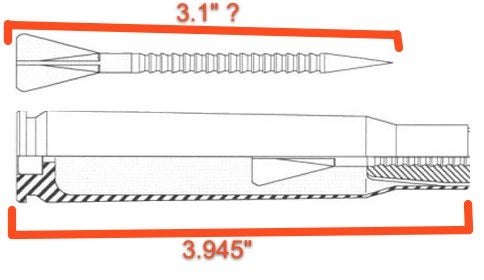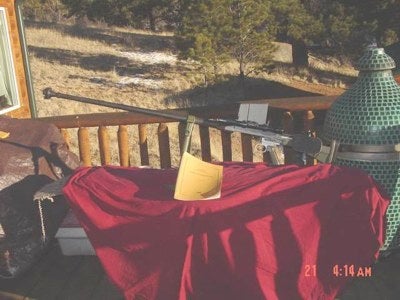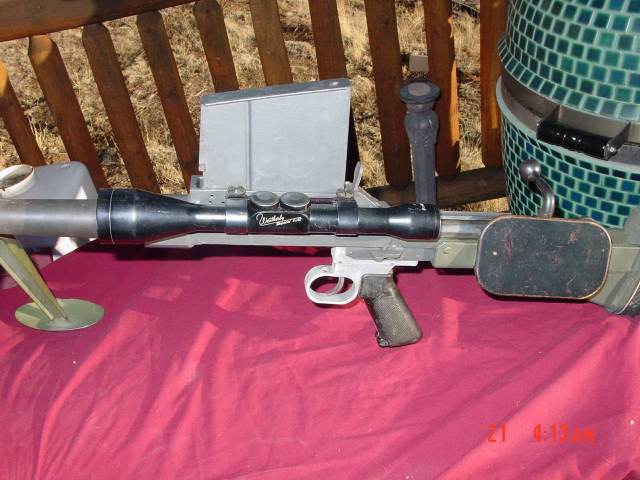Daniel spotted a very interesting auction at gunbroker.com. The rifle on sale was a Boys Anti- Tank rifle modified by TRW-SYSTEMS GROUP and rechambered for .50 BMG. It was intended to be used for .50 BMG flechette rounds.
The auctioneer claims that it is only one of twelve built and the only other known example resides at the Ford Benning sniper school.
The .50 BMG Flechette rifle project was contacted out by DARPA in 1960’s. The projectile consisted of a saboted depleted uranium dart weighing 11.9 gram ( 183.6 grains ).

.50 BMG Flechette round cross section. © Paul Smith (Used with permission)
The sabot was fired out of a smoothbore barrel with the dart achieving 4500 feet/sec velocity. That is more than a 32 grain .204 Ruger!

Detailed Drawing © Paul Smith (my modification are in red)
I tried to work out the caliber. Given that 1 cm3 of depleted uranium weights 19.1 grams and the length of the dart is 7.81 cm (I rounded down to 6cm to take into account the spiraling and the point) and then used the formula of a volume of a cylinder:
11.9 / 19.1 = 0.62
sqr(0.62 / ( 6 x pi )) = 0.18 centimeters
[ My math skills not great these days, go easy on me in the comments 😉 ]
A caliber of .07″ is seems some what small. It is impossible to know how much titanium is in the depleted uranium alloy.
Time Magazine wrote about the project back in 1967:
TRW’s magic bullets are unimpressive at first glance. Less than 4 in. long and one-tenth of an inch thick, they resemble the steel flechettes (French for “little arrows”) used in some U.S. antipersonnel weapons in Viet Nam. What the TRW flechettes lack in size, they make up in penetration power. In recent tests, they punched completely through a 2-in.-thick armor plate that would stop most steel flechettes or heavy-caliber bullets fired at it.
Dramatic Travel. It is the uranium that gives the flechettes their impressive muscle. Cleansed of its fissionable isotopes U-235, the depleted uranium is safe to handle. Because it is one of the heaviest natural elements (a 1-ft. cube of uranium weighs 1,167 lbs.), even a tiny uranium flechette fired at high velocity from a gun has so much kinetic energy that it can penetrate a target at an angle as oblique as 60°.
At 0.10 in caliber it would have an incredible ballistic coefficient weighing in at 180 grains! In theory it should be super accurate. In reality it was quite the opposite. It shot 10 shot groups of 6 – 8 feet at 600 yards. That’s over 12 MOA!
TRW was hoping to use the flechette in a rotary gatling / mini gun type system. Daniel writes:
The rifle in the GB [gunbroker] ad looks like the one shown in a photo in Peter Senich’s “The Complete Book of U.S. Sniping”. The photo was credited to Don Stoehr, a former TRW employee.
Among his projects were the Low Maintenance Rifle (LMR) and HIVAP (High Velocity All Purpose) machinegun. The HIVAP was really wild. It was an eight-barrel .31 caliber Gatling based on the Dardick open chamber principle. Like other Dardick-derived open chamber weapons, it used ‘trounds’. The HIVAP trounds used lexan cases loaded with saboted flechette. (However, solid bullet variants intended for testing purposes can be found.) The really wild part was the cyclic rate: just shy of 30,000 rpm. Stoehr later wrote that the twin feeders could support 42,000 rpm and that a switch to electrical priming would allow them to double the existing cyclic rate.
However, I don’t know how they’d ever keep such a monster fed. The weapon pod under design only held either 3,000 or 6,000 trounds.
It is an interesting cartridge that unfortunately will probably never be further developed due to the politics and health concerns of depleted uranium. Carrying DE rounds around would likely be a health hazard to the soldier using them.
More information on the round is available at cartridgecollectors.org.
Many thanks to Daniel E. Watters for information and links and to Paul Smith for the use of his photos.
 Your Privacy Choices
Your Privacy Choices

